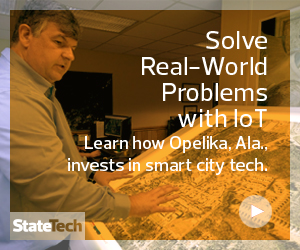IoT Reveals How the Nature of Networking Is Changing
Along with the other members of the Transition Networks team, I was stationed in a trailer that served as the command point. We relayed IP address and configuration information up to the top of the bridge over a radio and watched the progress via a live video feed from the technician. The install went smoothly, even with non-network engineers doing all of the hands-on work. The only challenge came when the technician had to press the tiny reset buttons on some of the equipment to start the devices. Thankfully, he found a paper clip to help with the job.
This trip to the top of the bridge is an example of the how the nature of networking is changing, and how the Internet of Things is changing both wired and wireless networks. Industry experts anticipate billions of “things” will be added to networks in the coming years. Wireless networks are the focus of much of this activity, but IoT also has an impact on wired networks, because there are a lot of IoT applications where wired connections are better suited.
MORE FROM STATETECH: Discover how smart cities can defend against botnet attacks.
Remote Management Reduces Requirements for Maintenance Trucks
Wired IoT applications include communications equipment, cameras, door locks, and digital signs. In comparison to wireless IoT applications, these systems are high-value, high-bandwidth, real-time systems, where constant uptime is critical. Both applications need power, and they need better management capabilities.
Maintenance truck rolls have always been an expense that network operators want to minimize, but when devices are located remotely, the cost of dispatching a truck can increase significantly, and servicing those devices becomes more difficult. Through the use of remote management, operators are able to limit the number of truck rolls and be better prepared to address specific issues when they do have to dispatch service technicians. This will become even more important in the era of wired IoT.
That was true on the Brooklyn Bridge. The new network will offer PoE++ (the latest standard of Power over Ethernet, which allows for greater amounts of power) to support the new wired IoT systems being installed on the bridge. The new systems replace existing equipment to provide better communications, security and functionality, but require higher power levels.
MORE FROM STATETECH: Find out how cities can overcome challenges to smart city deployments.
New Capabilities Enable Troubleshooting from Afar
The other key feature driving the new network was remote troubleshooting of the equipment. The effort it takes to access the equipment makes rebooting or fixing the gear at the top of the bridge one of the most difficult truck rolls.
The installed switches come with device management system software that provides the advanced tools necessary for total management of all powered devices. DMS provides discovery and mapping of powered devices, allows for troubleshooting of cable and IP connections, and enables the cycling of the powered device. So, by using the DMS instead of a making a harrowing climb to the top of the bridge, the equipment can be rebooted, adjusted and managed — all from a mobile device in an office in Brooklyn. It’s the kind of capability the city wants at all 13,000 traffic intersections across the five boroughs.
And it’s the kind of functionality that is becoming increasingly important in enterprises of all kinds.











